Prohibitory traffic sign
Prohibitory traffic signs are used to prohibit certain types of manoeuvres or some types of traffic.
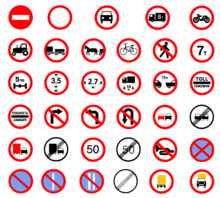
Modern prohibitory traffic signs
No entry
No admittance to unauthorised personnel, usually shown as a red circle with a white rectangle across its face. It is often used for one-way traffic.
 Australia
Australia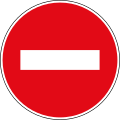 Botswana, Eswatini, Lesotho, Namibia, South Africa, Tanzania, Zimbabwe
Botswana, Eswatini, Lesotho, Namibia, South Africa, Tanzania, Zimbabwe Canada
Canada New Zealand
New Zealand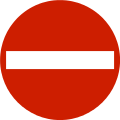 Norway, Indonesia
Norway, Indonesia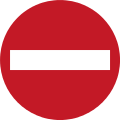 Philippines
Philippines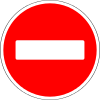 Russia, Belarus, Lithuania, Georgia, Armenia, Azerbaijan, Kazakhstan, Mongolia
Russia, Belarus, Lithuania, Georgia, Armenia, Azerbaijan, Kazakhstan, Mongolia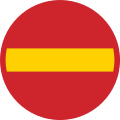 Sweden
Sweden United States
United States
Wrong way
These signs denote that the road is only for traffic coming in the opposite direction. Used at intersections to roads with one-way traffic or ramps.
 Australia
Australia Canada
Canada Norway
Norway United States
United States
Road closed
No admittance for vehicles. It is used on closed roads.
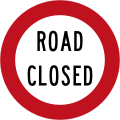 New Zealand
New Zealand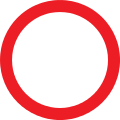 United Kingdom, and most European countries
United Kingdom, and most European countries United States
United States
No straight ahead
Traffic is not permitted to continue straight, and must usually turn. These may occur at an intersection with incoming one-way traffic.
 United States, Canada
United States, Canada
No motor vehicles
Motor vehicles are not permitted in this region.
 Norway
Norway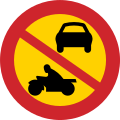 Sweden
Sweden United States
United States
No motorcycles
Motorcycles are not permitted in this area.
 Norway
Norway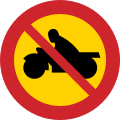 Sweden
Sweden United States
United States Indonesia
Indonesia
No heavy goods vehicles
Heavy goods vehicles are not allowed.
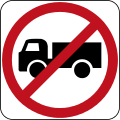 Australia
Australia Canada
Canada Canada (Québec)
Canada (Québec)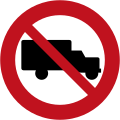 New Zealand
New Zealand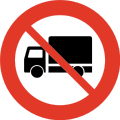 Norway
Norway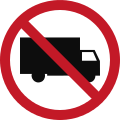 Philippines
Philippines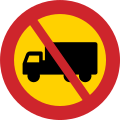 Sweden
Sweden United States
United States
No buses
Buses are not permitted.
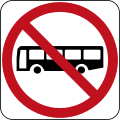 Australia
Australia
No pedestrians
Pedestrians are not allowed on the road, but may use a footpath instead.
 Australia
Australia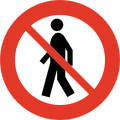 Norway
Norway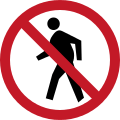 Philippines
Philippines Philippines (use overpass)
Philippines (use overpass) Philippines (use pedestrian crossing)
Philippines (use pedestrian crossing)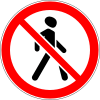 Russia, Belarus, Georgia, Armenia, Azerbaijan, Kazakhstan, Mongolia
Russia, Belarus, Georgia, Armenia, Azerbaijan, Kazakhstan, Mongolia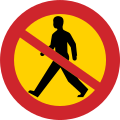 Sweden
Sweden
No pedestrians or bicycles
Pedestrians and bicycles are not permitted, but may be allowed on a footpath.
 Canada
Canada Norway
Norway United States
United States United States (also no motor-driven cycles are allowed[1])
United States (also no motor-driven cycles are allowed[1])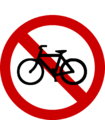 Indonesia
Indonesia
No right, left, or U-turn
Either for all vehicles or with some exceptions (emergency vehicles, buses). These are usually to speed up traffic through an intersection or due to street cars or other right of ways or if the intersecting road is one-way. Indicated near-universally by an arrow making the prohibited turn overlaid with a red circle with an angular line crossing it.
No right turn signs
.svg.png) Australia
Australia Botswana, Eswatini, Lesotho, Namibia, South Africa, Tanzania, Zimbabwe
Botswana, Eswatini, Lesotho, Namibia, South Africa, Tanzania, Zimbabwe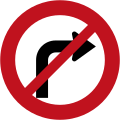 New Zealand
New Zealand Norway
Norway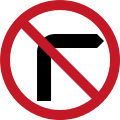 Philippines
Philippines.svg.png) Saudi Arabia
Saudi Arabia Sweden
Sweden United States, Canada
United States, Canada
No left turn signs
.svg.png) Australia
Australia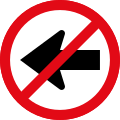 Botswana, Eswatini, Lesotho, Namibia, South Africa, Tanzania, Zimbabwe
Botswana, Eswatini, Lesotho, Namibia, South Africa, Tanzania, Zimbabwe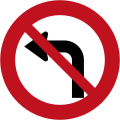 New Zealand
New Zealand Norway
Norway Sweden
Sweden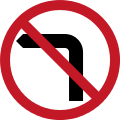 Philippines
Philippines United States, Canada
United States, Canada
No turn signs
 Canada
Canada United States
United States
No U-turn signs
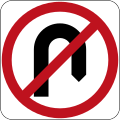 Australia
Australia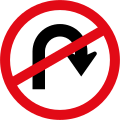 Botswana, Eswatini, Lesotho, Namibia, South Africa, Tanzania, Zimbabwe
Botswana, Eswatini, Lesotho, Namibia, South Africa, Tanzania, Zimbabwe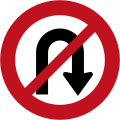 New Zealand
New Zealand Norway
Norway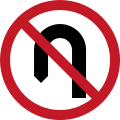 Philippines
Philippines.svg.png) Saudi Arabia
Saudi Arabia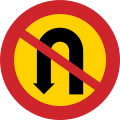 Sweden
Sweden United States, Canada
United States, Canada Caltrans (Left turn on green arrow)
Caltrans (Left turn on green arrow)
No left or U-turn signs
 United States
United States
Other turn prohibition signs
 Canada: No right turn and straight ahead
Canada: No right turn and straight ahead Canada: No left turn and straight ahead
Canada: No left turn and straight ahead
No overtaking
Either overtaking is prohibited for all vehicles or certain kinds of vehicles only (e.g. lorries, motorcycles, etc...). In the USA, this is usually phrased as "no passing zone" and indicated by a rectangular, black-on-white sign on the right side of the road that says "DO NOT PASS" and/or by a solid yellow line painted on the roadway marking the left limit of traffic (centerline), and sometimes supplemented by a yellow (no passing zone) sign on the opposite side of the road (where it can be seen by a driver who is attempting to pass). Conversely, when the passing restriction is lifted, a rectangular, black-on-white sign that says "PASS WITH CARE" is placed on the right side of the road and/or the yellow centerline changes from solid to broken (indicating that passing is allowed in that direction).
No overtaking or passing signs
 Canada
Canada Norway, typical for most parts of Europe
Norway, typical for most parts of Europe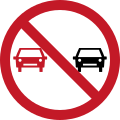 Philippines
Philippines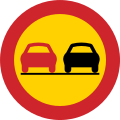 Sweden
Sweden Thailand
Thailand United States
United States
End of overtaking signs
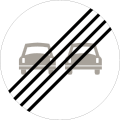 Norway
Norway Sweden
Sweden
Limits
Speed limits
See: Speed limit Used to indicate a maximum speed limit. The indicated limit is in mph in the USA and the UK, and in km/h in all other countries. Motorists are generally expected to be aware of this, as the majority of regulatory speed limit signs only list a number and no specific units.
Speed limit signs
.svg.png) Australia
Australia Canada
Canada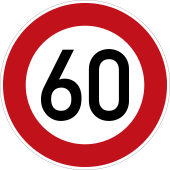 Germany, typical for most parts of Europe
Germany, typical for most parts of Europe.svg.png) New Zealand
New Zealand.svg.png) Philippines
Philippines Sweden
Sweden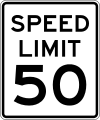 United States
United States Indonesia
Indonesia
End of speed limit signs; used to denote a previously posted speed limit that is no longer in effect on a road. State, local, or national speed limits usually govern speed after this point, unless another limit is posted.
 Germany, typical for most parts of Europe
Germany, typical for most parts of Europe.svg.png) Philippines
Philippines New Zealand[2]
New Zealand[2] United States
United States
Weight limits
Used denote maximum weight for bridges.
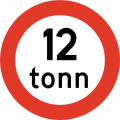 Norway
Norway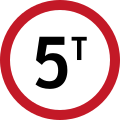 Philippines
Philippines.svg.png) Saudi Arabia
Saudi Arabia Sweden
Sweden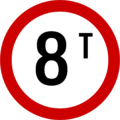 Indonesia
Indonesia
Width limits
Used to denote maximum width on narrow roadways.
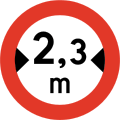 Norway
Norway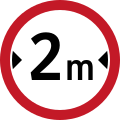 Philippines
Philippines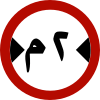 Saudi Arabia
Saudi Arabia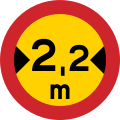 Sweden
Sweden Indonesia
Indonesia
Height limits
Used to denote height limit on bridges and underpasses
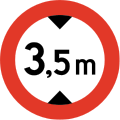 Norway
Norway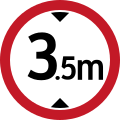 Philippines
Philippines.svg.png) Saudi Arabia
Saudi Arabia Sweden
Sweden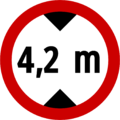 Indonesia
Indonesia
Length limits
Used to denote maximum length.
 Norway
Norway Philippines
Philippines Sweden
Sweden
No horns
Sounding your horn is not allowed for vehicles in some areas, most commonly in school zones, villages, or near hospitals or churches.
 Philippines
Philippines
No parking
Amongst one of the most familiar signs, this sign is used where parking is prohibited. Usually shown as a red diagonal bar inside a blue circle with a red ring in Europe and parts of Asia, and a 'P' in a red circle with a cross through in North and South America, elsewhere in Asia, Australia, Africa and Ireland. The no parking sign is a part of controlled parking zone sign, which is obsolete in Belgrade from 1997.
 Australia
Australia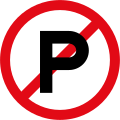 Botswana, Eswatini, Lesotho, Namibia, South Africa, Tanzania, Zimbabwe
Botswana, Eswatini, Lesotho, Namibia, South Africa, Tanzania, Zimbabwe Canada
Canada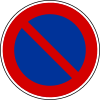 France
France_3b.svg.png) Indonesia
Indonesia New Zealand
New Zealand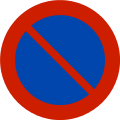 Norway
Norway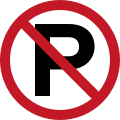 Philippines
Philippines United States
United States Caltrans: No parking at Any Time (R28)
Caltrans: No parking at Any Time (R28)
No stopping
This sign is used where parking and stopping is prohibited. Usually shown as a red cross inside a blue circle with a red ring in Europe and parts of Asia, and a 'E' in a red circle with a X through in South America.
Stop at customs
Stop at customs that are used at border crossings, toll roads or police.
 Norway
Norway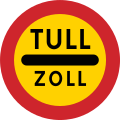 Sweden
Sweden Thailand
Thailand
End of restrictions
These are the signs that end restrictions.
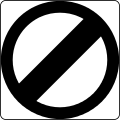 Philippines
Philippines
Other
 Philippines: No waiting anytime
Philippines: No waiting anytime
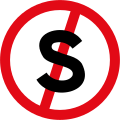

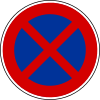
_3a.svg.png)
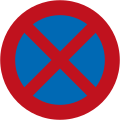
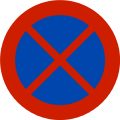
.svg.png)
